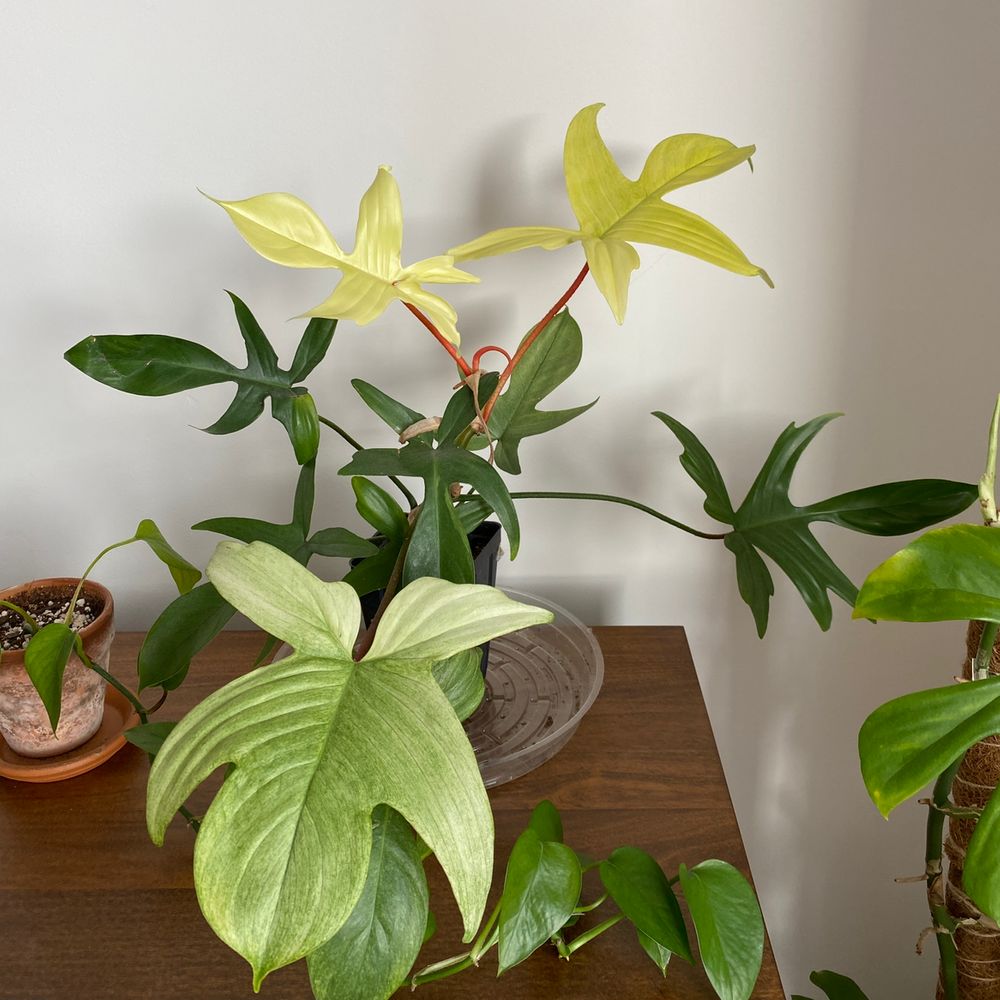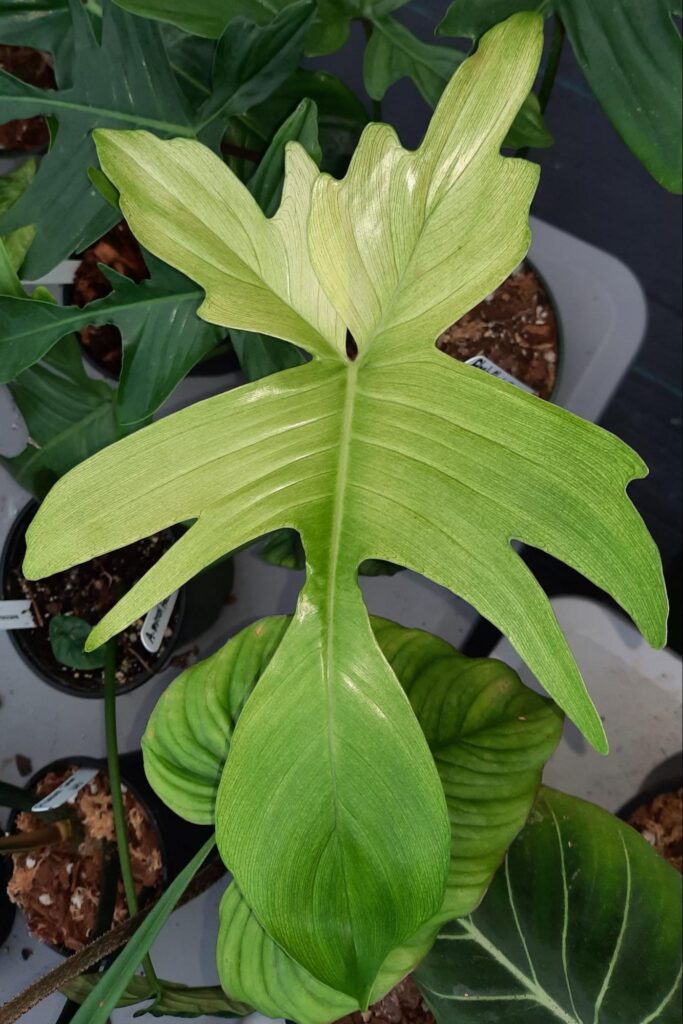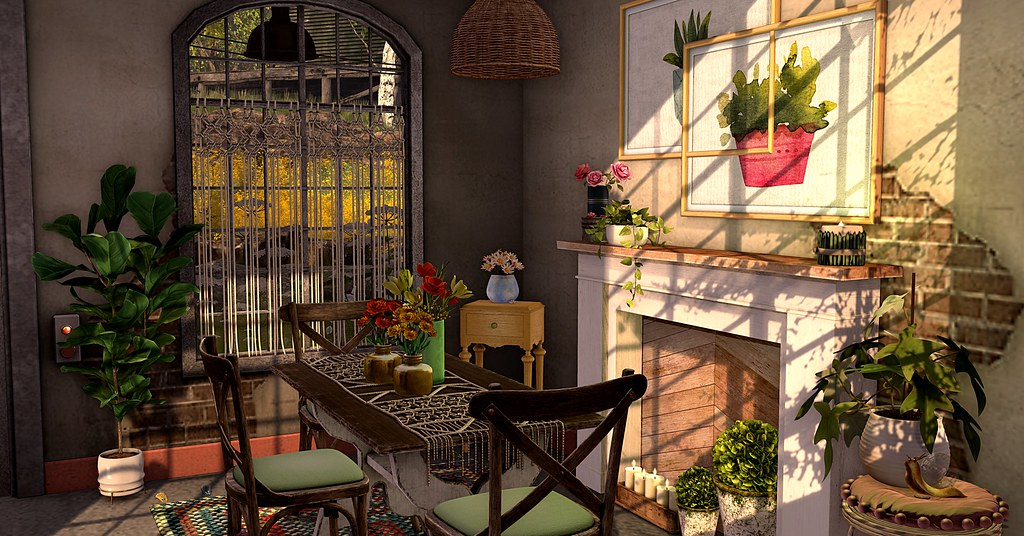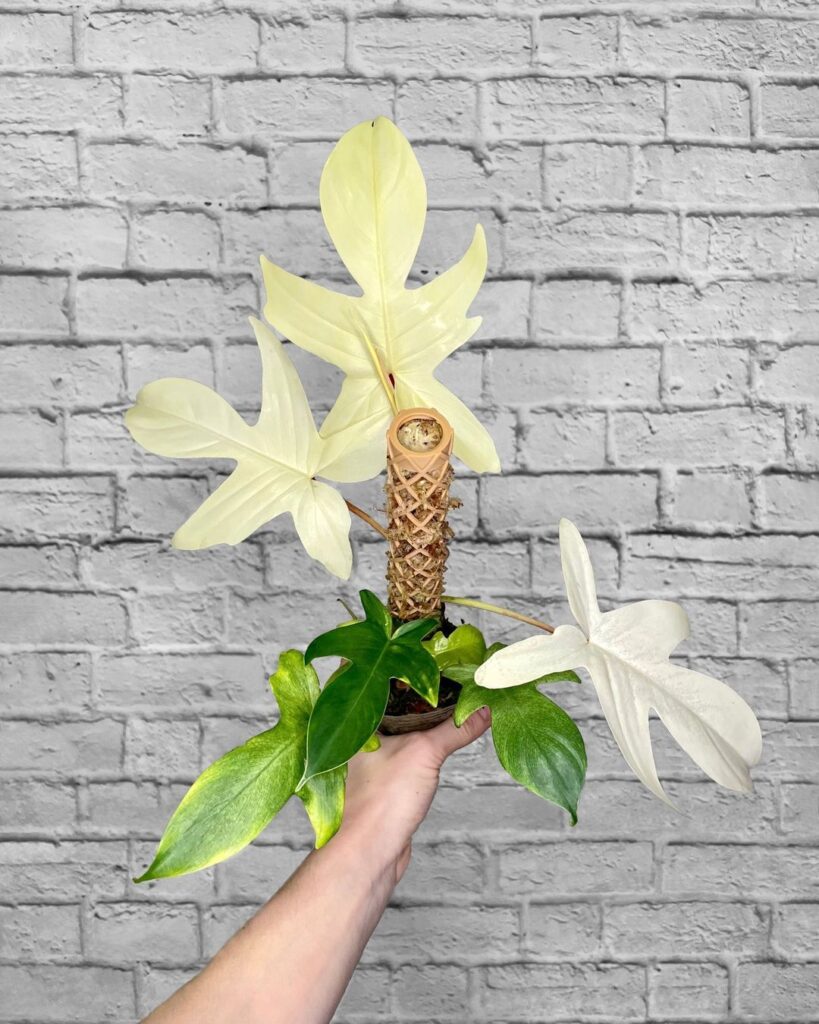The Philodendron Florida Ghosts are stunning indoor plants that are high in demand and have grown in popularity over time. They are very unique and are definitely stunners. They have white foliage that resembles flying ghosts, hence the name.

But don’t worry, these plants are not as frightening as their name implies. With their green or milky creamy-white ornamentally-shaped leaves, paired with red stems, nothing screams scary about these gorgeous plants!
Want to know more about this stunning Philodendron? Get more information about this plant below to start your journey in taming a beautiful ghost.
Philodendron Florida Ghost Profile
General Information
Philodendron Florida Ghost is a rare and beautiful evergreen Philodendron species. It is an epiphytic plant that is a member of the Araceae family, a close relative to Syngoniums, Alocasias, and Monsteras. The Florida Ghost is said to be a hybrid between Philodendron squamiferum and Philodendron pedatum. However, this is still not scientifically proven.
This tropical plant is usually cultivated into a houseplant, vine, or terrarium plant. It is native to the tropical forests of South America. Commonly, it is also known as Florida Ghost and White Ghost.
The common name is mainly due to its ghost-like foliage in the form of dark green or creamy-white leaves, giving it an elegant look in an indoor setting. The plant grows to a height of 2 to 4 feet and spreads to a width of 2 feet.
Etymology
The botanical name “Philodendron” comes from the Greek words “philo”, meaning “love” and “affection”, and “dendron,” meaning tree. So the Philodendron is loosely translated as “tree huggers” with these meanings. This is because they are often seen in the wild as tree climbers.
Moreover, “Pedatum” is a Latin word that means “footed”, referring to the divisions of the leaf that radiate outward from a common center, thereby resembling a foot.
Flowering
Philodendrons rarely bloom, but when they do, they produce spathes, leaf-like structures that are wrapped around a stalk of tiny flowers crowded together.
Season Of Interest And Purchasing
This plant grows actively from spring through summer. Therefore, you may want to purchase this plant during those times so you can supplement it with the right food and requirements.
Growth
Philodendron Florida Ghost grows slowly and takes its time to mature. This plant can spread up to two feet in length and grow up to five feet tall. The plant’s adult leaves can grow up to two to four inches long.
This plant develops quickly and in an upright pattern. It will be able to grow upward and bear its weight with the aid of a moss pole or trellis.
RELATED: 11 Frequently Asked Questions on How to Care for a Philodendron Birkin
Philodendron Florida Ghost Overview
| Scientific name | Philodendron cv. Florida Ghost |
| Common name/s | Florida Ghost, Philodendron Florida Ghost, White Ghost |
| Family | Araceae |
| Growth Habit | Herbaceous Vine |
| Height and Spread | Up to two to four feet in height and spreads around two feet |
| Classification based on life cycle | Perennial |
| Origin and Distribution | Originates from South America |
| Climate Zone | Generally warmer climate |
| USDA Plant Hardiness Zone | USDA Zone 9-11 |
| Color | Green with milky cream to white marbled leaves with red stems |
Care Tips

Light Requirement
Wild philodendron plants can be found in Central and South American tropical rainforests. Tropical plants like the Florida ghost thrive in bright, indirect sunlight to encourage the creamy white foliage. It can withstand some direct sunlight but avoid the hot midday sun to keep the leaves from scorching.
During winter seasons, your Philodendron might use a little help. You can use grow lights, especially if your plant is placed in darker home environments or office spaces where light is scarce and not readily available. Your plant will grow even better if it has enough bright indirect light, so make sure they get the right amount they need.
If your Philodendron plant starts to develop leggy and long leaves and considerable distances between the internodes of the leaves, it means your plant is not receiving the right amount of light. So again, direct sun is definitely a no-no, or you will have crispy leaves!
Temperature Requirement
The Philodendron Florida Ghost, a native of South America’s tropical regions, prefers to grow in an environment with constant temperatures between 64 and 77 degrees Fahrenheit. A plant will grow without any issues if you provide it with a comfortable temperature.
Please don’t leave them outside when it is below 50 degrees Fahrenheit because they are not frost-or cold-resistant. The plant’s growth will be severely stunted, leading to small leaves, wilting, or even death under unfavorable temperature conditions.
Water Requirement
Philodendron Florida Ghost, like most Philodendrons, prefers moist soil, dampy but not soggy. This might take some balancing and getting used to, but you’ll learn its preferences once you’ve watered your plant long enough. It is essential, though, to avoid overwatering as it can lead to root rotting, one of the main culprits of deaths of Philodendrons.
To water your plant, check first the soil. Stick your fingers into the topmost soil; if they are completely dry, your plant needs watering. Please pay attention to its leaves also. When it starts to have drooping leaves or yellow leaves, it means your plant is being overwatered or underwatered.
To avoid this, rectify the watering schedule of your Florida Ghost to about twice a week, depending on your indoor air quality, climate, and moisture level. You may use tap water for this plant.
Humidity Requirement
For a more efficient photosynthesis, the humidity level is crucial. Philodendrons thrive in humid environments. Your Florida Ghost can tolerate humidity levels up to 60%-70% in homes.
One way to keep your plant happy is by misting its leaves. You can spray fine mist above your plant’s leaves every 2-3 days on regular days, while you may need to do it daily during hot days. You can use a regular spray bottle.
Other ways to provide sufficient humidity are using room humidifiers (particularly around 40% humidity), pebble tray humidifiers, or simply grouping the house plants. This proximity among the plants can create a natural humid atmosphere, similar to their native environment.
RELATED: Philodendron Red Emerald: The #1 Care, Propagation and Watering Guide
Soil Requirement
Philodendron Florida Ghost prefers moist soil that is not excessively saturated. The soil should be rich but light and airy. Fast-draining, high-organic-matter potting mixtures are ideal for them. This is to avoid becoming muddy or waterlogged.
To make the soil less likely to compact, mix it with organic materials such as peat moss or sphagnum moss, and aerators such as perlite or pumice.
Fertilizer Requirement
Philodendron Florida Ghost will need fertilizer during the growing season to supply it with the nutrients it needs to grow. In order to promote growth in the spring and summer, it is suggested to apply some slow-release fertilizer and feed once a month.
Furthermore, the 7:9:5 NPK ratio is the best choice for fertilizer. It will give the plants the essential nutrients they need to thrive rather than just survive.
It may also be helpful to flush the soil every once in a while, specifically about every four to five months, to avoid salt buildup. To do this, run water slowly through the potting mix for two to three minutes. You can resume with regular watering and feeding when the top 1 inch of soil has already dried.
Space Requirement
Philodendron Florida Ghosts simply dislike being crowded and need space around them for light and air circulation. Therefore, they do best with smaller plants around them or alone in an open area, preferably in a north or east-facing window.
Growing And Planting Tips

Propagation
The Philodendron Florida Ghost propagation is primarily done in two ways. It can be done via(1) Stem cuttings and via (2) air layering. Both methods are easy and straightforward and guarantee success in reproducing your plant. Below are the detailed steps to propagate your Florida Ghost.
Propagation by Stem cuttings
The stem cutting technique requires you to cut stems from a mother plant. Put the shoot in a rooting medium to attain this. After the roots have been established, the cutting can be treated as a separate plant and allowed to grow in the desired location. Simply cut the stem tip to 5 to 7 inches. Take out a few of the bottom leaves.
Plant the cutting in moist, easily prepared soil. Ensure at least three nodes are beneath the soil to allow for root development.
Propagation by Air layering
Air layering encourages stems to grow new roots, trees, and shrubs from stems that are still attached to the parent plant. To encourage root formation, the stem is wrapped in damp moss. After the roots have formed, the new plantlet is separated from the mother plant and potted in its own container.
By then, the roots should have developed over the next 1 to 3 months, and the plant should have begun to grow leaves from the top.
Pruning
Pruning the Philodendron Florida Ghost is not necessary for its health, but it can help the plant maintain its shape. Since this plant is a natural climber, it has a tendency to grow “leggy.” As a result, they need to be pruned. Remove any dead or dying leaves and cut long stems just above a node.
The new growth should give the plant a bushier appearance in the pot. This allows the plant to concentrate its energy on producing healthy, colorful foliage.
RELATED: Pothos Vs. Philodendron: How To Tell Between The Two Popular Houseplants?
Potting And Repotting
It is not necessary to repot this plant because it grows slowly. However, although this plant is prone to root-bound situations, consider repotting it in a larger plant pot every 2 to 3 years in the early spring to ensure it maintains its healthy growth.
However, if you notice that the roots are coming out of the drainage holes, you must repot them as soon as possible to avoid the roots becoming cramped.
Philodendron Florida Ghost Care
| Light | Bright, indirect sunlight |
| Temperature | Intermediate to warm, 64–77 degrees Fahrenheit |
| Water | Once a week, increased in summer, decreased in winter |
| Soil | Light and airy, well-draining soil |
| Fertilization | Regular household fertilizer, once a month |
| Space | More space needed, does not like getting cramped |
| Propagation | Via stem propagation and air layering |
| Blooming | Enough sunlight and maturity needed |
| Pruning | Regular pruning not needed |
| Potting | Regular potting mix, use of perlite, sphagnum moss, coco coir, and pumice is recommended |
Problems And Troubleshooting

Overwatering
Overwatering a plant might result in more serious symptoms than merely yellowing leaves. It will cause root rot, sogginess, and permanent root degradation as a result of excessive water use, which tends to result in insufficient soil moisture or moisture stress, preventing the plant from receiving enough oxygen and nutrients to generate chlorophyll.
To prevent overwatering, Stick your index finger into the soil 1 to 2 inches. If it seems dry, water it. If it feels moist or wet, wait a few days before testing again. Furthermore, ensure the pot has good drainage and let the soil dry between waterings.
Underwatering
Underwatering Philodendron Florida Ghost causes dry leaves, brown tips, leaf drops, withering, and leaf curling.
To preserve the health of the plant, maintain the watering pattern and supply the plant with bright, indirect light to help it survive. Water it thoroughly, making sure to provide water to the roots, and try decreasing the time between waterings.
Nutrient Deficiency
Plants can suffer from deficiencies when growing conditions are inadequate, and the plants are unable to absorb nutrients from the soil.
Philodendron Florida Ghost is best fertilized with nitrogen, phosphorus, potassium, and sulfur to encourage green, lush growth. Deficiencies of these nutrients result in yellowing and stunted development of your Philodendron.
Flowering Problems
Philodendron Florida ghost plant blooms very seldom, especially for a potted plant grown indoors. This plant will only flower if it is fully mature, which takes many years.
Philodendron Florida Ghost Pests and Diseases
| Common Pests/Diseases | Symptoms | Treatment and Prevention |
Common diseases include crown rot, stem rot, root rot, bacterial leaf spot, fire blight, fungal diseases, and Xanthomonas infection | Yellowish rimming around black or dark brown spots on leaves | Avoid overwatering. Keep soil dry. Avoid too high humidity.Proper ventilation is needed around the plant. Remove infected parts of fungal infections to avoid spreading. |
| Common pests include mealybugs, spider mites, aphids, and scales | Visible insects on the surface | Spray plants with warm, soapy water. If infestation is present, use insecticide or neem oil. Use diatomaceous earth. |
Problems with People And Animals
Toxicity
Due to the calcium oxalate crystals in all the plant parts, the Philodendron Florida Ghost is poisonous to young children and animals. Therefore, children or dogs should not be given any part of the plant because doing so could have harmful effects.
The poisonous crystals in this plant can cause vomiting, trouble swallowing, profuse drooling, acute burning in the mouth, lips, and tongue, as well as oral irritation.
Philodendron Plants Meaning And Symbolism
Philodendrons are a wonderful choice for plant lovers or someone with a strong passion for eco-friendly living because they represent a love of nature.
In addition, they represent personal development and would be a wonderful gift for someone going through a significant life event or making improvements in themselves.
| General Meaning | love of nature, passion for eco-friendly living |
| Symbolism | Personal growth |
Landscaping And Gardening Ideas

Companion Plants
Other tropical plants go well with Philodendrons. Some of the plants you may consider include bird of paradise, areca palms, fire spike, heliconia, variegated arboricola, croton, chenille plant, and pentas. Some of these plants will have additional colors and hues of warm oranges and reds, perfectly complementing your excellent dark greens.
If you want to add other Philodendron plants, the Philodendron Brandtianum, Philodendron Prince of Orange, and Philodendron Pink Princess, make excellent plant partners for Florida Ghost Philodendron. Their gorgeous extended and lengthy leaves, as well as their lovely foliage colors, complement well the white hues of your Philodendron Florida Ghost plants.
Landscaping Ideas
Medium-sized Philodendrons go well as accents inside a humid room, cozy deck, or patio. A full plant can also be placed in the corner of the house or along the entryway. Outdoors, it can be a filler plant for a garden corner, in between palm trunks, or under tall trees. It can also be placed near pools to add even more tropical vibes as long as it won’t get splashed at.
You can also grow your White Ghost in hanging baskets or planters to make beautiful wall art by placing it on a floating shelf. Hang metal wall art, particularly geometric designs, and train the vines to climb along the metal. It creates a lush tropical environment.
| What to plant with | Other Philodendronds, Bird of Paradise, Areca Palms, Fire Spike, Heliconia, Variegated Arboricola, Croton, Chenille Plant, Pentas |
| What NOT to plant with | Basically nothing |
Conclusion

The Philodendron Florida Ghost, rumored to be a hybrid of Philodendron squamiferum and Philodendron pedatum, is definitely a must-have if you aim for an exotic, dashing tropical vibe. The new leaves appearing as white as ghosts will truly mesmerize anyone who will see them.
Despite the name, there is nothing spooky about this climbing plant. In fact, this is the perfect plant to amplify the beauty of your home. Adding this rare Aroid species will be one of the best choices you’ll ever make in your life.
Frequently Asked Questions
Is the Philodendron Florida Ghost rare?
The Philodendron Florida Ghost is an extremely rare Philodendron variety. It is a rare species that has a name based on how its young foliage grows. The young leaves are as white as ghosts before they become green when they mature.
This particular hybrid is an extremely rare Philodendron that was once sold in an online auction for about $12,000.
Does Philodendron Florida Ghost climb?
The Florida Ghost Philodendron is a herbaceous vine that loves to climb. That is why it is best to consider adding a pole or trellis for your plant to support its climbing needs. The addition of climbing material will enhance the growth of your Florida Ghost.
What is the difference between the Philodendron Florida Ghost plant and Philodendron Florida Ghost Mint?
The common names’ Philodendron Florida Green’, ‘Florida Ghost Mint’, ‘Florida Ghost’ are just invented commercial names intended to make a difference between a Beauty, a Ghost, and a regular Florida. However, they are just the same plants, just with a slight variation of color due to differences in environmental conditions.
Essentially, the Florida Ghost Mint refers to just a paler Florida Ghost due to light exposure.
Is Philodendron Florida Ghost a hybrid?
The Philodendron Florida Ghost is said to be a hybrid of Philodendron squamiferum and Philodendron pedatum. However, this information is still unconfirmed at the present.
How do you take care of a Philodendron Florida Ghost?
The Philodendron Florida Ghost variety is a low-maintenance plant that is easy to care for. However, to properly take care of this plant, you must meet its basic light, water, soil, fertilization, and humidity requirements.
Study about this plant and know what to avoid and what to do when met with certain problems. The more you know about your plant, the more you will likely take care of it properly.
Editor’s Recommendations
Philodendron White Princess: The Complete Care, Propagation, and Watering Guide You Need
Philodendron verrucosum: The Number 1 Care, Propagation, and Watering Guide for This Velvety Plant
Philodendron Splendid: The Fail-Proof Care, Propagation, and Watering Guide You Need







